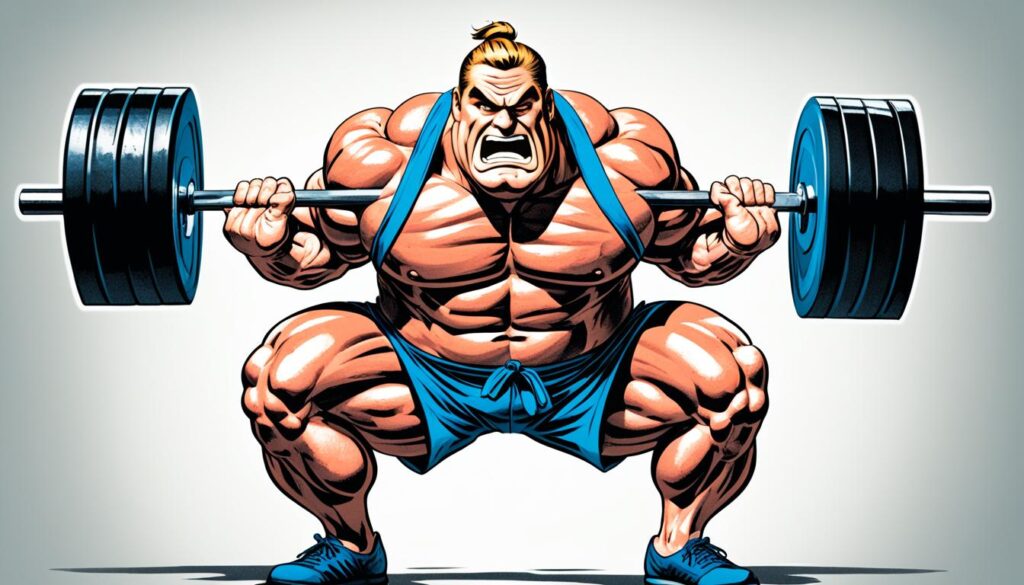Getting Started with what does deadlift workout
Did you know that the deadlift is considered one of the most effective exercises for building full-body strength? It’s true! Whether you are a seasoned athlete or just starting your fitness journey, incorporating deadlifts into your workout routine can yield remarkable results.
But what exactly does the deadlift workout entail and how can it benefit you? In this article, I will guide you through the basics of the deadlift exercise, its technique, and the muscles it targets. We will also delve into the various benefits that the deadlift offers, from increased strength gains to muscle development. Additionally, I will introduce you to different deadlift variations and additional exercises that can amplify the impact of your deadlift routine.
Key Takeaways:
- The deadlift is an effective exercise for achieving full-body strength.
- By incorporating deadlifts into your workout routine, you can experience increased strength gains and muscle development.
- Proper technique and form are crucial for performing the deadlift safely and effectively.
- There are several variations and additions to the traditional deadlift exercise that you can incorporate for added variety and enhanced benefits.
- Whether you are a beginner or advanced fitness enthusiast, the deadlift can help you achieve your fitness goals.
Understanding the Deadlift Exercise
When it comes to building overall strength and sculpting a powerful physique, few exercises are as effective as the deadlift. This compound movement engages multiple muscle groups simultaneously, making it an essential addition to any fitness routine. In this section, we will delve into the specifics of the deadlift exercise, exploring its proper technique, and identifying the key muscles worked.
The Deadlift Technique
The deadlift exercise involves lifting a barbell or weighted object from the floor to a standing position, using a specific lifting technique. Proper form is crucial to maximize the benefits and minimize the risk of injury.
“The deadlift is a fundamental compound exercise that primarily targets the lower body while also engaging the upper body and core muscles,” explains renowned fitness expert, Amy Roberts.
To perform a deadlift, follow these steps:
- Stand with your feet shoulder-width apart, toes pointing slightly outwards.
- Bend at the hips, keeping your back flat and your chest lifted.
- Grasp the barbell with an overhand grip, hands slightly wider than shoulder-width apart.
- Engage your core, and with slow and controlled movements, lift the barbell by extending your hips and knees.
- Continue lifting until you are standing upright, ensuring your shoulders are pulled back.
- Lower the barbell back to the starting position, maintaining proper form.
Remember, it’s essential to maintain a neutral spine throughout the movement and avoid rounding your back, as this can lead to injury. Always start with lighter weights to master the technique before adding more weight.
Muscles Worked during a Deadlift
The deadlift is a full-body exercise that activates numerous muscle groups. Understanding the muscles targeted will help you appreciate the effectiveness of this compound movement.
| Muscle Group | Main Muscles Worked |
|---|---|
| Lower Body |
|
| Upper Body |
|
| Core |
|
The deadlift exercise engages these muscle groups in a coordinated effort, developing functional strength and stability throughout your body.
Now that you understand the proper technique and the muscles worked during a deadlift, you’re ready to experience the transformative power of this compound exercise. In the next section, we will explore the numerous benefits of incorporating the deadlift into your fitness routine.
Benefits of Deadlift Workout
When it comes to achieving optimal strength gains and muscle development, incorporating deadlifts into your fitness routine can have remarkable benefits. The deadlift is a compound exercise that engages multiple muscle groups simultaneously, making it an efficient and effective workout for building overall strength and power.
One of the key advantages of deadlifts is their ability to stimulate muscle growth in various areas of the body. This exercise primarily targets the muscles in the lower body, including the glutes, hamstrings, and quadriceps. The deadlift also activates the muscles in your core, back, and upper body, providing a comprehensive full-body workout.
By consistently performing deadlifts, you can expect to see noticeable improvements in muscle mass and definition. The high level of muscle activation during deadlifts promotes hypertrophy, which is essential for achieving significant muscle development. Whether your goal is to develop strong, powerful legs or build a well-rounded physique, the deadlift can play a crucial role in achieving your desired results.
Another significant benefit of incorporating deadlifts into your fitness routine is the enhancement of overall strength and power. Deadlifts require a high level of force production, which translates to increased strength gains over time. As you progressively increase the weight you lift during deadlifts, your muscles adapt and become stronger, resulting in improved physical performance.
In addition to strength gains and muscle development, deadlifts also offer several functional benefits. The deadlift is a fundamental movement pattern that mimics real-life activities such as lifting heavy objects from the ground. By regularly performing deadlifts, you can improve your ability to perform everyday tasks, reduce the risk of injury, and enhance your overall functional fitness.
The benefits of deadlifts extend beyond physical gains. This compound exercise can also have a positive impact on mental well-being. Deadlifts require focus, concentration, and mental resilience, which can help improve cognitive function and enhance your overall mental strength.
Summary:
The benefits of incorporating deadlifts into your fitness routine are extensive. From building overall strength and power to enhancing muscle development and promoting functional fitness, deadlifts offer a variety of advantages. By consistently including deadlifts in your workouts, you can unlock your full potential and make significant progress towards your fitness goals.
Deadlift Variations and Additions
Now that you have a solid understanding of the traditional deadlift exercise, it’s time to explore some exciting variations and additions to spice up your routine. By incorporating these deadlift variations, home workouts, and exercises targeting the upper body such as the press, you can add variety and further enhance the benefits of your deadlift routine.
Kettlebell Deadlift
If you’re looking for a way to challenge your muscles and add some intensity to your deadlift workout, the kettlebell deadlift is a fantastic option. This variation involves using a kettlebell instead of a barbell, which requires increased stabilization and engages your core more intensely. It’s a great way to develop overall strength and improve your grip strength.
Single-Leg Deadlift
The single-leg deadlift is an excellent exercise for targeting your glutes, hamstrings, and core stability. By performing the deadlift on one leg, you are not only building strength but also improving balance and coordination. Incorporate this variation into your routine to take your deadlift to the next level.
Sumo Deadlift
The sumo deadlift involves a wider stance and a grip between your legs. This variation shifts the focus to your inner thighs and glutes, making it an excellent choice for targeting those specific muscle groups. It also emphasizes the quadriceps and puts less stress on the lower back, making it a suitable option for individuals with back pain.

Home Workout Deadlift
Don’t have access to a gym or a barbell? No problem! You can still perform deadlifts at home using alternative equipment such as dumbbells, resistance bands, or even filled water bottles. These improvised deadlift variations are a convenient way to continue your strength training routine without leaving the house.
Upper Body Presses
To further enhance the benefits of your deadlift routine, incorporate upper body presses such as the overhead press or the bench press. These exercises engage your chest, shoulders, and triceps, providing a balanced upper body workout. By combining deadlifts with upper body presses, you can maximize your training efficiency and achieve overall strength gains.
By trying out these deadlift variations and additions, you can keep your workouts interesting, challenge your muscles, and achieve well-rounded strength development. Remember to always prioritize proper form and gradually increase the intensity as your strength improves.
Conclusion
In conclusion, the deadlift workout is a powerful exercise that can significantly contribute to achieving full-body strength. By incorporating this exercise into your fitness routine, you can unlock its numerous benefits and maximize your results.
Throughout this article, we have explored the basics of the deadlift exercise and emphasized the importance of proper technique and form. Understanding how to perform a deadlift correctly is crucial to ensure safety and maximize the effectiveness of the workout.
Furthermore, we have discussed the various benefits of the deadlift workout, including its ability to build overall strength, increase power, and enhance muscle development. Whether your fitness goals involve improving athletic performance, gaining strength, or simply maintaining a healthy physique, the deadlift can be a valuable addition to your routine.
Incorporating deadlift variations and additions, such as using kettlebells or incorporating upper body exercises like the press, can add variety and challenge to your workout. This diversity keeps your routine fresh and allows you to target different muscle groups, further enhancing your strength gains.
FAQ
What is a deadlift workout?
A deadlift workout is a type of strength training exercise that involves lifting a weighted barbell or dumbbells from the floor to a standing position. It primarily targets the muscles in your lower body, including your hamstrings, glutes, and quadriceps, but it also engages your back, core, and upper body.
What are the benefits of doing deadlifts?
Deadlifts offer numerous benefits, such as improving full-body strength and power. They help build strong hamstrings, glutes, and lower back muscles, which can enhance your athletic performance. Deadlifts also promote muscle development in your upper body and core, improve posture, and increase overall stability and balance.
What is the proper technique for performing a deadlift?
To perform a deadlift, stand with your feet shoulder-width apart and bend your knees to grip the barbell or dumbbells. Keep your back straight, core engaged, and chest lifted as you lift the weight off the floor by extending your hips and knees. Make sure to maintain a neutral spine and avoid rounding your back.
Can I do deadlifts at home without a barbell?
Yes, you can modify deadlifts for a home workout by using kettlebells or dumbbells instead of a barbell. Kettlebell deadlifts are an effective alternative that still engages the same muscles. By holding one or two kettlebells at your sides and following the same technique, you can perform a deadlift at home.
How can I target my upper body while doing deadlifts?
You can incorporate upper body exercises such as the press into your deadlift routine to target your upper body muscles. After completing a deadlift, hold the weights at shoulder height and press them overhead, engaging your shoulders, chest, and arms. This adds an upper body component to your deadlift workout.
